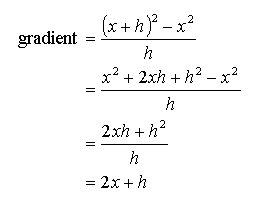the gradient of the graph at the point P.

I have a question to differentiate y=x2 by first principles. The answer is 2x, isn't it? |
The question says you should differentiate y = x2 by first principles.
This means you are not allowed just to write down the answer using any
'short-cut' rules, but must use the 'official' method as follows:

First, consider a sketch of the graph of y = x² (right).
You have to find an expression for ![]() , which represents
, which represents
the gradient of the graph at the point P.
Point P has coordinates (x,x²) and
Q is a nearby point with coordinates (x + h,(x + h)²).
The line through P and Q has almost the correct gradient.
Its gradient is
![]()
So

Now this answer of 2x + h is almost the correct answer for ![]() .
.
As Q 'slides down' to get closer and closer to P:
We write:

This is the answer you expected, but done without reference to any 'short cut' rules!